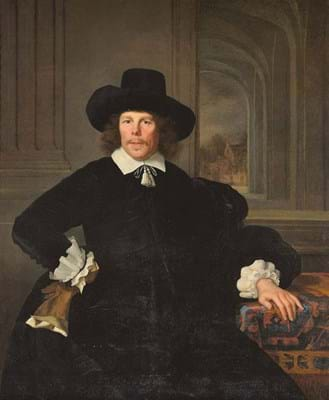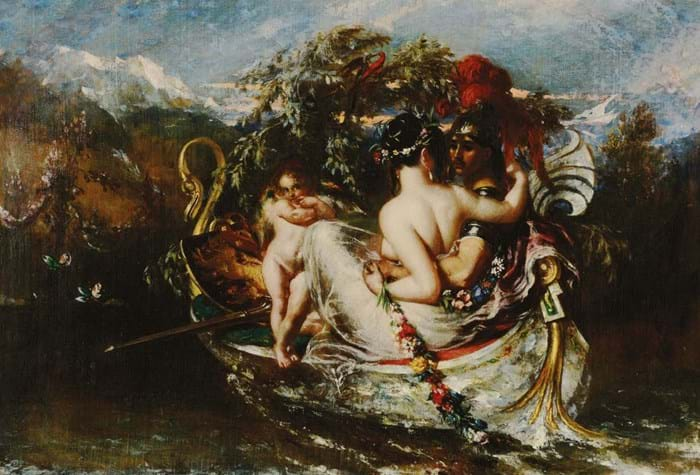Oakley House in Suffolk, a large Georgian farmhouse, was the final residence of Eustace Gibbs, 3rd Baron Wraxall (1929-2017) and contained items collected by four generations of the Gibbs family.
Their 19th century wealth was built on the importation and sale of top-grade Peruvian guano, which became a best-selling fertiliser in Britain.
Some of the pieces were previously at Tyntesfield, the family’s Gothic revival home sold to the National Trust in 2002. The modern pictures, many of which improved on their previous sale prices, were acquired at auction over the last three decades by Lord Wraxall during his career as a British diplomat.
Helped by sensitively pitched estimates, the sale totalled just under £580,000 from 233 lots with a bullish sell-through rate of 96%.
Joe Robinson, from the house sales and private collections team at Dreweatts, said the broad appeal of the lots for sale “offered something for everyone resulting in record numbers of sale registrants”.
Market-fresh Old Masters
Among the pictures, the collection’s biggest hitters were two market-fresh Dutch Old Masters that attracted multiple bids and eventually sold to the UK trade. The rarity and long-standing provenance of these works undoubtedly contributed to the interest.
The first, a portrait of a gentleman in a black hat and suit, was a rare work by Louis Vallée (c.1620-53). Just five results are listed on the Art Sales Index attributed to the artist, who is thought to have been of French origin and was active in Amsterdam between 1646-52.
Of those works which are known, the majority are history paintings or portraits. Similarities to the work of Amsterdam painter Jacob Backer (1608-51) has led to the speculative suggestion that Vallée may have been his student.
The picture had formerly been in the American collection of Emma Rockefeller McAlpin and sold in a sale at The American Art Association in New York in 1935.
At Dreweatts it was knocked down to the UK trade at £30,000, twice the lower guide. Only one other painting by the artist has made more at auction according to the Art Sales Index: a full-length portrait of three children that sold at Sotheby’s in 2008 for £55,250 (with fees).
The second Dutch Old Master was lot 15, a large 2ft 7in x 3ft 7in (79cm x 1.11m) Italianate landscape in oil by Jan Both (c.1615-52), which was knocked down at £48,000 against hopes of £20,000-30,000. It depicted Ponte Molle on the River Tiber in north Rome, the site of the famous battle of the Milvian Bridge between Roman emperors Constantine I and Maxentius.
Both was born in Utrecht in c.1615 to a glass painter and engraver and became a pioneer of Italianate landscape painting in 17th century Holland, celebrated for his depictions of radiant landscapes bathed in sunlight, many of which were concocted in his imagination. His style was based on the work of Claude Lorrain with whom he collaborated in Rome.
In 2000, Christie’s sold an Italianate evening landscape by Both with provenance to the famous 17th century collector, Pieter Cornelis, for £1.3m – a price that has yet to be matched at auction. Christie’s painting had belonged to a small group of works, remarkable for their size and painted late in the artist’s career.
Twentieth century works
The Red Hat, a striking portrait by Gerald Kelly (1879-1972) painted in 1972, drew multiple bids before it was knocked down at £22,000, nearly four times its top guide. The 2ft 9in x 2ft 1in (84 x 64cm) oil on canvas had been acquired in 1998 by Lord Wraxall from the Royal Exchange Art Gallery in London and had previously sold at Sotheby’s in Sussex in 1993 for the modest sum of £2800. Also purchased from the same source was In the Luxembourg Gardens, a small undated oil on panel by Kelly, which took £4500 against a £800-1200 guide.
Finding a buyer at £22,000 was one of Walter Sickert’s (1860-1942) views of Dieppe, the picturesque French seaside town that became a significant setting for both his personal and professional life. The 13¾ x 10¼in (35 x 26.5cm) oil on panel of a street corner, painted in c.1907, had last sold for £14,000 at Christie’s London in June 2003.
Edward Seago (1910-74), another favourite of Lord Wraxall, was represented by four works, three of which outstripped their guides.
The highest price was reserved for a small, but exquisitely executed painting of the beach near Winterton in Norfolk. The 10 x 16in (26 x 41cm) oil on board sold to a private UK buyer at £20,000. It had formerly been with London dealer Colnaghi before selling to Lord Wraxall for £12,000 at Christie’s in June 2005. It was closely followed by a Moroccan view by the artist, which also sold to a private buyer for £18,000, up on the £11,000 Lord Wraxall paid for it at Christie’s London in June 2003.
Lake placid
Getting away just below top estimate at £14,000 was William Etty’s (1787-1849) Phaedria and Cymochles on the Idle Lake, a 22in x 2ft 7in (59 x 79cm) oil on canvas which was exhibited at the Royal Academy in 1835.
It was one of the few highlights to sell at a loss. On its previous auction outing it had made £17,000 as part of the Forbes Collection at Christie’s London in 2003.
Inspired by Edmund Spenser’s epic poem The Faerie Queene, it tells the tale of the knight Cymochles, a man of rare undoubted might but given all to lust and loose living who sets out to avenge the death of his brother Pyrochles but is interceded by Phaedria, the lady of the Idle Lake who symbolises immodest mirth.
Despite a largely positive reception when it was exhibited at the Royal Academy, the critic for The Times wrote a damning review, saying the work was “…a most disgusting thing… Phaedria is the true representative of one of the Nymphs of Drury lane, and Cymochles looks like an unwashed coalporter”.
Another version of Phaedria and Cymochles by Etty is at Princeton University Art Museum, New Jersey and the studies for which can be found at the V&A in London.



















